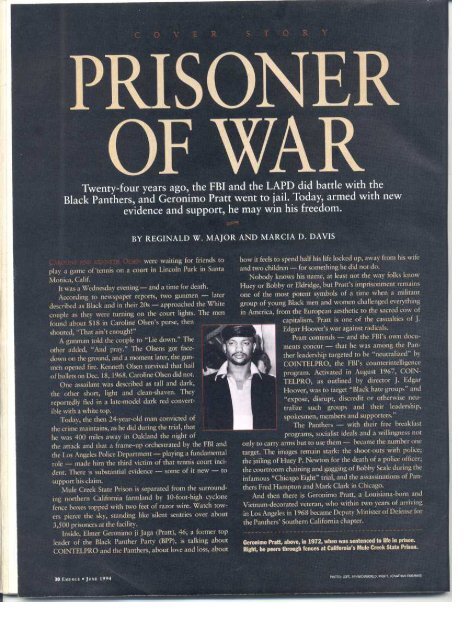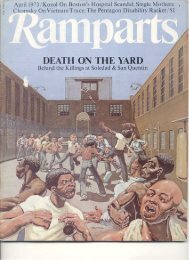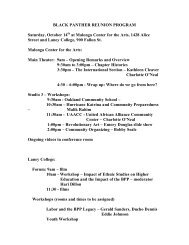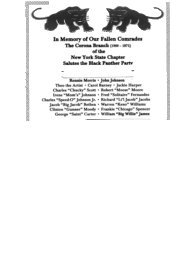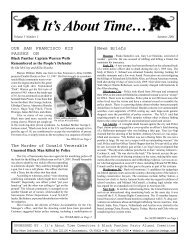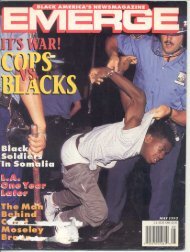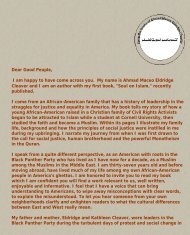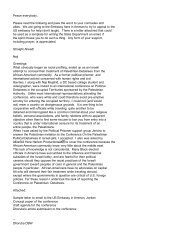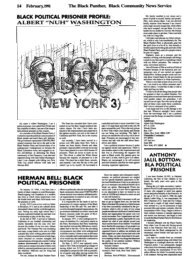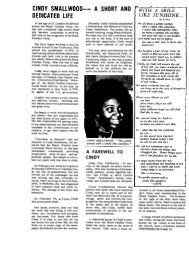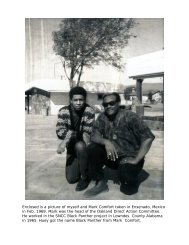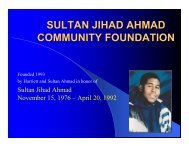Emerge Magazine - It's About Time
Emerge Magazine - It's About Time
Emerge Magazine - It's About Time
You also want an ePaper? Increase the reach of your titles
YUMPU automatically turns print PDFs into web optimized ePapers that Google loves.
says Harry Sondheim, one of three lawyers in the<br />
D.A.'s office working on the case.<br />
Meanwhile, the case is getting a new round of<br />
attention. The Fox- TV affiliate in Los Angeles ran a<br />
three-part series on Pratt in January. Other media<br />
organizations have expressed interest. Members of<br />
the Congressional Black Caucus, NAACP Executive<br />
Director Ben Chavis, Amnesty International and others<br />
support Pratt.<br />
Pratt, however, takes the recent developments in<br />
stride. The evidence that should have been enough to<br />
free him has been around for years, he says. Other<br />
powerful people -including former Republican Rep.<br />
Pete McCloskey and Democratic Rep. Don Edwards,<br />
both of California -have worked on Pratt's behalf.<br />
Pratt was a quarterback for Sumpter Williams High in Morgan City, La. Right, in 1967, His story even aired on 60 Minutes in 1987.<br />
before he served two tours in Vietnam. He later put his military training to use at home. "Twenty-four years on a single murder?" asks<br />
Pratt during an interview at Mule Creek. "I've seen<br />
Within four years, he was serving life in prison.<br />
"What I've seen convinces me that [Pratt) was intentionally<br />
framed by the FBI, starting with the highest position within the<br />
FBI, J. Edgar Hoover," says Stuart Hanlon, one of Pratt's<br />
lawyers.<br />
Says lay minister James McCloskey, who began<br />
investigating the Pratt case last year, "I don't think Pratt "was intenthere's<br />
any doubt that, from the top down, Hoover<br />
branded the Panthers the most dangerous threat to<br />
national security."<br />
In some ways, Pratt's case is like a spy novel. A<br />
police informant with a "secret" letter was the prosecution's<br />
key witness. That witness, Julius Butler,<br />
declined <strong>Emerge</strong>'s request for an interview. FBI surveillance<br />
documents that could have supported<br />
Pratt's alibi have mysteriously disappeared. Key<br />
information, including Butler's relationship to the<br />
FBI and LAPD, was suppressed during the trial,<br />
along with the crucial fact that Kenneth Olsen had<br />
identified another man as one of his attackers a year<br />
before he fingered Pratt.<br />
The FBI declined to discuss the case. "We have no comment<br />
because of the on-going prosecutory and judicial reviews of this<br />
case," says John Kundts, an agency spokesman. The LAPD<br />
issued a similar response.<br />
But now after 12 failed parole attempts and<br />
numerous efforts to get a new trial, the Los Angeles<br />
district attorney has agreed to review the case.<br />
It appears to be the best chance yet for Pratt to<br />
win his release.<br />
McCloskey's investigation and report submitted<br />
last September convinced the district attorney,<br />
Gil Garcetti, to agree in January to a review. "I<br />
read all the trial transcripts and it was apparent to<br />
me that Pratt did not do this crime," explains<br />
McCloskey, head of the Princeton, N.J.-based<br />
Centurion Ministries, which gained national<br />
attention in 1992 for helping to free Clarence<br />
Chance and Benny Powell, two Black Los Angeles<br />
men wrongly jailed for 17 years for the death of a<br />
sheriff's deputy .<br />
"We're still in the process of reviewing the<br />
case and the information<br />
from McCloskey,"<br />
guys go out with two and three murders -16,17,18 years, at<br />
the most."<br />
Since 1978- the year Pratt first was eligible for parole -<br />
every Los Angeles district attorney and chief of police has written<br />
letters opposing his release, claiming he is<br />
a danger to the community. That includes<br />
tionally framed...<br />
starting with the<br />
highest position<br />
within the FBI, J.<br />
Edgar Hoover."<br />
C:::==9<br />
current police Chief Willie Williams, the<br />
African-American recruited from philadelphia<br />
after the L.A. civil unrest in 1992.<br />
For Pratt, the parole board has been simply<br />
another frustration.<br />
"1 refused to go to the parole board for<br />
eight, nine straight years because I was told<br />
by the parole board they have to consider the<br />
conviction, and the conviction has me as a<br />
convicted murderer," he explains. "I'm not a<br />
murderer. I didn't do the murder."<br />
He says the only killing he has done was<br />
in Vietnam.<br />
Elmer Pratt did two tours of duty in Vietnam.<br />
He enlisted after high school on the<br />
advice of the elders in his hometown of Morgan City, La. In<br />
1968, he returned home with Silver and Bronze Stars and two<br />
Purple Hearts.<br />
Pratt married Ashaki Icenter) in a prison<br />
waiting-room on Dec. 3, 1976. They have a<br />
daughter (left), Shona, 14, and son, Hijori,<br />
Upon returning to Louisiana, Pratt's<br />
sister asked him to drive her to Los<br />
Angeles where she was to attend the<br />
University of California. He had every<br />
intention of returning home, but when<br />
she suggested he attend UCLA too, he<br />
stayed. Three months later, the Olsens<br />
were shot and robbed.<br />
It had been only two years since<br />
Bobby Seale and Huey P. Newton<br />
began patrolling the streets of Oakland<br />
as the Black Panther Party for Self<br />
Defense, but the party was already a<br />
national movement. By 1969, it had<br />
about 40 chapters and was serving free<br />
breakfasts to about 10,000 children<br />
monthly. It had opened several free<br />
clinics, and <strong>Time</strong> magazine reported<br />
that The Black Panther newspaper had<br />
32 EMERGE. JUNE 1994 PHOTOS: TOP, COURTESY THE PRATT FAMILY: BOTTOM: JONATHAN EUBANKS FOR EMERGE
a weekly circulation of about 100,000.<br />
But COINTELPRO was also on the march. COINTELPRO<br />
and local police intelligence units, such as the LAPD's Criminal<br />
Conspiracy Section, were busy recruiting informants and infiltrators<br />
to undermine this new movement. Still, the Panthers<br />
were strong, and it was an exciting time to be bold, Black and<br />
beautiful. Some were students, others former gang members<br />
who had traded criminal pasts for revolutionary futures. Some,<br />
still entrenched in crime, hung onto the edges of the party .<br />
UCLA was electric, and the Panther leader there, Alprentice<br />
"Bunchy" Carter, had mesmerized the campus. He recruited<br />
Elmer Gerard Pratt, who's part Native American, and nicknamed<br />
him "Geronimo. " (Pratt later changed his name to ii Jaga,<br />
after a West African warrior who fought colonialists.)<br />
When Carter was gunned down in January 1969 by members<br />
of a cultural nationalist group vying for power at UCLA,<br />
"G" was chosen to take his place.<br />
At the time Pratt was joining the Panthers, so was Julius Butler,<br />
who became the party's director of security for Southern<br />
California. But Butler, then 36, and a former deputy sheriff, was<br />
more than that- much more. According to FBI and LAPD documents,<br />
he was an informant, first for the LAPD, then the FBI.<br />
Butler had had his eye on the deputy minister of defense post. By<br />
then, party members had suspected Butler of being an informant,<br />
and the 21-year-old Pratt, respected for his demolitions<br />
know-how from the military, got the job.<br />
Pratt, acting on those suspicions, demoted Butler and on<br />
Aug. 8,1969, expelled him. They were actions that, McCloskey<br />
says, hardened Butler against Pratt. On Aug. 10, 1969, Butler<br />
delivered a letter to a contact on the LAPD. Sgt. DuWayne Rice<br />
OTHER POliTICAL PRISONERS<br />
"THE LAW DOES NOT PUNISH PEOPLE for their political beliefs," says<br />
Carl Stern, a spokesman for the U.S. Department of Justice. But several<br />
human rights groups disagree.<br />
Amnesty International spokesman Andrew Kelly says U.S. political<br />
prisoners are nothing new. The organization defines a political<br />
prisoner as "any prisoner whose case has a significant political element:<br />
whether the motivation of the prisoner's acts, the acts in themselves,<br />
or the motivation of authorities."<br />
Nkechi Taifa, co-chair of<br />
the criminal justice section of the National Conference of Black<br />
Lawyers, estimates that some 75 percent of the more than 100 U.S.<br />
political prisoners are African-American<br />
or Puerto Rican.<br />
T aifa says the most egregious of political prisoner cases share<br />
several similarities: prior to their arrests, they were subjects of the<br />
FBI's COINTELPRO<br />
project that targeted Black activists; they<br />
received unprecedented sentences and remained behind bars longer<br />
than nonpolitically<br />
active people charged under the same statutes.<br />
Also, many political prisoners live under unusually harsh conditions,<br />
with a disproportionate<br />
number having served time at Marion<br />
(Ill.) Federal Penitentiary, the nation's highest security prison, which<br />
has been condemned by Amnesty International.<br />
ABU-JAMAl<br />
Among some of the more well-known political<br />
prisoners:<br />
MUMIA ABU-JAMAL, a former Black Panther<br />
known for writing about police mistreatment<br />
of the militant MOVE organization and other<br />
Philadelphia Blacks. He was called "voice of<br />
the voiceless" by the Philadelphia Inquirer,<br />
and was included in a Philadelphia <strong>Magazine</strong> list of "people to<br />
watch." In 1981, Abu-Jamal was charged with killing a police officer.<br />
Although a ballistics expert testified that bullets found at the<br />
scene could not be matched to Abu-Jamal's gun, he was sentenced to<br />
death row in 1982 by Judge Albert Sabo, who has sentenced more<br />
people to death -31, only two of whom were White -than any<br />
other judge. Abu-Jamal's lawyers are seeking a post-conviction<br />
release hearing.<br />
MUTULU SHAKUR, a doctor of acupuncture, cofounded<br />
the National Task Force for COINTEL-<br />
PRO Litigation and Research, through which he<br />
has helped political prisoners such as NAACP<br />
Executive Director Benjamin Chavis. Chavis was<br />
imprisoned between 1971-80 as one of the<br />
"Wilmington 10" convicted of a grocery store bombing. In 1988,<br />
Shakur was convicted of a Brinks truck robbery and violating the<br />
Racketeer Influenced and Corrupt Organizations Act (RICO) on the<br />
testimony of a paid government witness, although no physical, scientific<br />
or eyewitness evidence linked him to the crime scene, says his<br />
ODINGA<br />
lawyer Jonathan Lubell. In March,<br />
Shakur was moved to Marion.<br />
In 1983, SEKOU ODJNGA was convicted<br />
on two of the same charges. As a result<br />
of police torture, he was hospitalized for<br />
three months after his capture. Odinga's<br />
first three years were served at Marion.<br />
Then he was moved to Leavenworth<br />
(Kan.) Federal Penitentiary where he<br />
remains. He is trying to obtain a transfer<br />
to an Atlanta facility, so he can be close to ill family members.<br />
SUNDIATA ACOU'S activism began in 1964, registering Black Mississippians<br />
to vote. After a 1973 confrontation on the New Jersey Turnpike,<br />
in which one of Acoli's companions was killed, he was charged with<br />
killing a state trooper and sentenced to life plus 30 years. In Trenton<br />
AtOll .<br />
I State Prison, Acoli lived almost five years in<br />
a cell smaller than the Society for the Prevention<br />
of Cruelty to Animals' required<br />
space for a German shepherd, and was then<br />
moved to Marion for eight years. In<br />
~ December 1993, he was denied parole for<br />
the next 20 years, the longest parole set off<br />
in New Jersey history. An appeal of the<br />
I d . I d thi S .<br />
paro e erna was presente s prmg.<br />
HERMAN BELL, JAUL ABDUL MANrAQmN AND ALBERT NUH<br />
WASHINGTON are the so-called "New York 3. " These former Black<br />
Panthers were charged with the 1971 murder of two New York<br />
police officers. Freedom of Information<br />
their case resulted from a Nixon administration<br />
militant Blacks. Code named NEWKILL,<br />
Act documents show that<br />
conspiracy to jail<br />
this alleged plot was developed<br />
five days after the murders. A 1991 evidentiary hearing proved<br />
that a police ballistics expert concealed test results showing that the<br />
alleged weapon had not been used in the killings. According to Brian<br />
Glick, the trio's attorney, the prosecution's star witness -who<br />
been tortured with cattle prods to his groin area -swore<br />
had<br />
he lied at<br />
the trial under pressure from police and prosecutors. Lawyers are<br />
petitioning for review by the U.S. Supreme Court.<br />
-Lori<br />
S. Robinson<br />
I i<br />
j<br />
JUNE 1994. EMERGE 33
~<br />
~ .,<br />
: j .'~.<br />
c ~ ,<br />
".,.-. .<br />
c7"' f -#~- ~ } I<br />
f'. f ,..~"e c:..c~ ! ~<br />
c,. .;: ~:' . ,<br />
T<br />
has said Butler told him he thought the Panthers were<br />
out to kill him. During the meeting on an L.A. street<br />
corner, Rice said in a sworn statement in November<br />
1979, Butler handed him a sealed envelope with the c<br />
words, "Only to be opened on the event of my death."<br />
The envelope contained information about Pratt's<br />
alleged confession to Butler on Dec. 19, 1968, about a<br />
Santa Monica tennis court robbery and murder.<br />
Moments after the meeting, Rice has said, two FBI<br />
officers approached and asked for the letter. Initially,<br />
Rice refused, but later complied.<br />
<strong>Emerge</strong> has examined numerous FBI documents<br />
that show Butler was an informant for the LAPD at<br />
least by 1966 and for the FBI by May 1969. Rice and<br />
then fellow officer, Capt. Ed Henry, both have said<br />
Butler turned over weapons to them at least two<br />
months before he wrote his "insurance policy."<br />
And an FBI memo dated June 5, 1969, states that<br />
"almost daily contact has been maintained with Butler<br />
and that he is alert for any information concerning...<br />
specific plans by the BPP involving the captioned individual<br />
[Pratt] to commit bank robberies, and will furnish<br />
positive information as soon as it is received."<br />
Another FBI document dated Jan. 28, 1970, stated,<br />
"Operation Number One is designed to challenge<br />
the legitimacy of the authority exercised by Elmer<br />
Geronimo Pratt." It took a year for the FBI to get its<br />
hands on the letter. Rice said he turned it over after<br />
Butler called and said the agency was "jamming" him.<br />
The document became the basis for the indictment<br />
against Pratt, and Butler's court testimony was pivotal<br />
to the conviction. During the trial, Butler denied ever<br />
having been an FBI or LAPD informant. He also<br />
denied he had been expelled from the party. Several<br />
jurors have since said that had they known about Butler's lawenforcement<br />
ties, they would have found Pratt not guilty .<br />
Butler is now a lawyer in L.A. His activities, though primary to<br />
Pratt's conviction, were not the only steps taken to put Pratt away.<br />
In November 1970, two years after the crime, and one<br />
month after the letter was opened, Kenneth Olsen and another<br />
wimess identified Pratt as the assailant from 16 photos. The<br />
shorter of the two assailants wore a safari-type jacket. In the<br />
photos shown to Olsen, Pratt was the only one<br />
wearing a similar jacket. In a previous lineup<br />
shortly after the attack, Olsen had identified<br />
another man as the shorter of the two attackers.<br />
There was only one problem: The man he<br />
identified was in prison at the time.<br />
Panther Tyrone Hutchinson was placed in a<br />
lineup in 1970 in an attempt for Olsen to identify<br />
the taller assailant. But no positive identification<br />
could be made. When Hutchinson was<br />
arrested in 1970, he told the two officers questioning<br />
him that neither he nor Pratt had been<br />
involved in the murder. He also told police that<br />
he had heard details of such a hold-up from<br />
two habitual criminals from his L.A. neighborhood<br />
who were peripheral party members and<br />
I<br />
r.;. "" , .~.,. ~-t<br />
r I J..~ ~ .'- -.." .ccccc B<br />
.c-. ;, c- c~-c~<br />
I i cC \ .,<br />
\.c.<br />
~ ,. '»P .. .<br />
\ I#"." , -~-~4<br />
" ~, 1\ ,~ .c<br />
. I ~c .' , .'<br />
.'r;.;) ,<br />
~ .,"'~ ~ ---: ,. c c<br />
~~.~<br />
P~<br />
0;'<br />
~:<br />
i<br />
.<br />
-: ;. 1, ;<br />
.,<br />
f .<br />
i~~<br />
~~~<br />
'8<br />
~<br />
Independent investigator McCloskey was startled to find how closely two other<br />
Panthers fit police sketches of the assailants described by victim Kenneth Olsen.<br />
Larry Hatter, left, and Herbert Swilley, right, were never placed in a police line-up.<br />
Conspiracy Section, warned that he had better not say anything<br />
about what he heard, if he knew what was good for him.<br />
Hutchinson was never indicted, although he was named in Butler's<br />
letter as Pratt's partner in the crime. None of the encounters<br />
between Hutchinson and Sgts. Jess Buckles and Raymond Callih;in<br />
made it to light during the trial. There were other irregularities.<br />
Pratt's legal team says it was compromised by the FBI. "It<br />
was mysterious," says Johnnie Cochran, Pratt's trial attorney at<br />
the time and now a lawyer for Michael Jackson.<br />
"The prosecution was always ready for us, whatev-<br />
"It wasn't until er we planned. It wasn't until the trial was over that<br />
we discovered that our team had been infiltrated."<br />
the trial was over Probably one of the most disheartening aspects<br />
of Pratt's trial was the lack of support he received<br />
that we discovered from other Panthers. Pratt had said that he was in<br />
Oakland at a major Panther meeting on Dec. 18,<br />
that our (legal] 1968. But by the time his trial came around in<br />
1972, the Panthers had suffered a major split. Huey<br />
Newton and Eldridge Cleaver were feuding, and<br />
team had been Pratt had allied himself with Cleaver and was<br />
expelled. Newton ordered other Panthers not to tesinfiltrated<br />
regularly committed crimes in Santa Monica.<br />
Hutchinson said in a 1991 signed statement<br />
that the two officers, members of the Criminal ~<br />
tify on his behalf. In 1991, however, Bobby Seale<br />
and David Hilliard gave affidavits stating that Pratt<br />
[by the FBI]." was at those discussions on the night in question.<br />
Hilliard says Newton showed him letters that he<br />
received while in prison stating that Pratt was planning<br />
to assassinate him."It was the FBI's work to<br />
34 EMERGE. JUNE 1994
...1~ /lnl:icl~tec1 t!l t tl,l:l co"nt~r~"t.el11::el~c~<br />
prCl?o=-~l cl."\;ld ~t:rv~ ~z one ph3.:c or a. Co"t111\\OI;= attc=r;t<br />
to ~eny ur.:.1:~. or ~c'.; l:1n j n tho errol.t c!' the LA BI'!' \)y<br />
c~..~ln1,~ :0 QUC;I:~Cln tilC :f,C:t10!\~ or thc or;;.n1::&t1cn ,.nd the<br />
le!:1t11/IACY of 1ts lr"'..cier:;h.lP.<br />
It 1~ r"lt tl~t..t..'1~ pr~\;:t.1O11 a:1c di:l:rjbutlC'n<br />
or tl'l~:\~ lca.rlcl:= co..,ld 'tIc =uch ~h:: t tt.c 1d~l..ti t.). or t.hc<br />
Fn! ,,:-. tl1C ~0III.CC 0.'" t:1c j.'rOp(1~~~ o\"Car.1%at~..11 coulc bc<br />
c:rr~cI:.1...cly concl..~lca.. .<br />
~- "OD,. 0 '...1<br />
These documents are among many obtained from the FBI's files, naming<br />
Julius Butler, inset, as a member of the Black Panther Party who regularly<br />
informed on his comrades and their activities. Butler is now a lawyer.<br />
keep us all confused," he says. "We were getting letters from<br />
everybody. Phones were tapped. They created mass distrust."<br />
Though more Panthers coming to Pratt's defense no doubt<br />
would have helped him, it was not the only way his alibi could<br />
have been corroborated.<br />
In 1985, a retired FBI agent who had worked in Los Angeles,<br />
testified in one of Pratt's many attempts to win a new trial,<br />
and said he believed Pratt was framed. He also verified that<br />
Pratt had been under surveillance between Nov. 15 and Dec.<br />
20 of 1968, and that there had been records of Pratt making a<br />
phone call from Oakland about three hours before the Olsens<br />
were shot.<br />
But when he went to look for those<br />
records in the mid-70s, Wesley Swearingen<br />
says, they were missing. The 25-year<br />
FBI veteran also swore in an affidavit<br />
that the FBI arid LAPD's Criminal Conspiracy<br />
Section worked closely during<br />
that period. He also said he heard the<br />
officer assigned to Pratt say, "The son of<br />
a bitch was in Oakland," referring to<br />
Pratt's whereabouts on Dec. 18.<br />
As information favorable to Pratt's<br />
case continued to roll in, Pratt's lawyers<br />
worked diligently for years to get the<br />
California courts to offer a new trial;<br />
each time they were rebuffed.<br />
By 1992, frustrated by continued<br />
denials by the courts, Pratt's team decided<br />
on another strategy. They contacted<br />
McCloskey after hearing about his suc-<br />
Elmer Geronimo ii Jaga Pratt can only look<br />
toward the future and possible freedom.<br />
cess with Chance and Powell<br />
McCloskey set out doing what he has done for 13 years: a<br />
grass-roots investigation. Following up on the tip that Hutchinson<br />
had given the two sergeants of the Crin1inal Conspiracy Section,<br />
McCloskey went door-to-door in Hutchinson's neighborhood<br />
looking for information on Larry Hatter and Herbert Swilley.<br />
Besides Hutchinson, McCloskey uncovered the names of at<br />
least three other childhood friends of Swilley and Hatter. The men<br />
all said they had heard either one or both men talking about a tennis<br />
court robbery and shooting in Santa Monica. He also learned<br />
that both men are now dead, in separate incidents. Swilley was<br />
killed over a gambling dispute on Jan. 9,1972, and Hatter on July<br />
19, 1978, from a head injury suffered during an attempted rob"<br />
bery -ironically on a tennis court in Santa Monica.<br />
What McCloskey found most startling about the two men<br />
was how closely they fit the descriptions of the Olsen<br />
assailants. Also, several people told<br />
McCloskey that "the goat," as Pratt's 1967<br />
red and white GTO convertible was called,<br />
was a Panther car, to which several members<br />
had access. Even Butler admitted that<br />
he had driven it on numerous occasions.<br />
McCloskey says he believes Swilley and<br />
Hatter, both Panthers, used the car in the<br />
tennis court shooting without Pratt's<br />
knowledge. But will coming so close to possibly<br />
solving the crime, or at least raising<br />
reasonable doubt, be enough to free Pratt?<br />
That's an answer that no one in Pratt's<br />
camp knows.<br />
"I think it's unfortunate that 'G' has been<br />
put in a position to have to prove his innocence,"'<br />
says another of Pratt's attorneys<br />
Adjoa Aiyetoro. "He's forced to prove his<br />
innocence by solving the crime, while everyone<br />
else is innocent until proven guilty." .<br />
III<br />
PHOTOS: TOP.AP/WIDEWORLD; RIGHT.JONATHAN EUBANKS FOR EMERGE<br />
1994 JUNE. EMERGE 35


